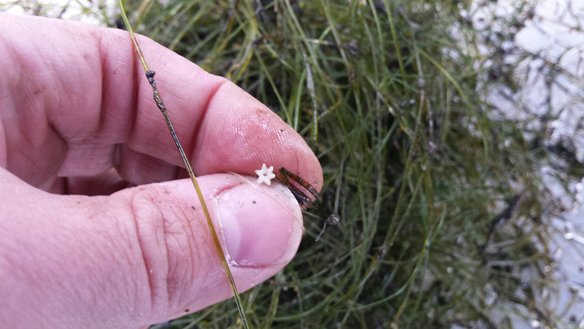Starry Stonewort

Species at a Glance
Starry stonewort is a rooted alga descended from some of the earliest life forms on earth and thought by scientists to have been the ancestors to all plants. Its ability to degrade ecologically sensitive areas and proliferate rapidly makes it a highly invasive species.
Species Description
This robust alga grows more than 2 m (7 ft) long. It is a light green color when actively growing. One way to distinguish starry stonewort from other species is by the tiny, star-shaped, tan-colored reproductive structures called bulbils. Its long, straight branches are arranged in whorls of 4-6 and can reach up ot 80 cm (31 in) long and will “pop” when squeezed. Dark red to orange reproductive structures called oogonia (female) and antheridia (male) can occur in the nodes of the branches, although all North American populations appear to be male. Instead of forming uniform mats, this alga forms irregularly spaced “pillows’ of dense vegetation that can resemble a Swiss cheese pattern when growth declines in the spring.
Starry stonewort looks similar to a native species called chara; however, chara lacks the star-shaped bulbils and does not ”pop” when squeezed.
Native & Introduced Ranges
Native to Europe and western Asia, and classified as endangered in Great Britain, starry stonewort was first reported in the St. Lawrence River in 1978 and the St. Clair River in 1983. In 2005, starry stonewort was reported in Oneida Lake in New York, and in 2006 it began to rapidly expand its range throughout inland lakes in Michigan. It has since spread to Wisconsin, Vermont, and Pennsylvania where it can be found in Lake Arthur in Butler County, and Presque Isle Bay in Erie County.
Biology & Spread
Starry stonewort was most likely introduced to North America in the ballast water carried by ocean-going ships. It can spread rapidly by fragments, as well as by the small, star-shaped bulbils that can remain viable in the sediment for many years. These fragments can be spread between lakes by boats, trailers, and anchors holding the sediments, or by water currents. Because only male starry stonewort exists in the U.S., no viable seeds are produced.
Habitat
Stoneworts live in fresh or brackish water and tolerate low nutrient and light levels. They are found at depths from 1 m (3 ft) to greater than 6 m (20 ft) in lakes or slow-moving rivers. They prefer alkaline waters rich in calcium carbonate and have the ability to grow on organic and inorganic substrates. They can also absorb nutrients through all surfaces, not just through the rhizoids.
Impacts
Threat to Biodiversity
Starry stonewort forms dense mats of vegetation that can be up to 2 m (7 ft) thick. These mats can completely cover a lake bottom, decreasing light availability and reducing the biodiversity of aquatic plants and other species that are dependent on bottom resources, such as minnows, clams, darters, and invertebrates. The mats can also impede the movement of native fish and other organisms, decreasing the availability of habitat for successful spawning activities. In addition, starry stonewort has been associated with increased water clarity in inland lakes, possibly due to their association with zebra mussels as a favored substrate.
Economic Costs
Dense mats of starry stonewort can interfere with recreational and other uses of lakes and potentially damage boats and equipment. Swimming can also be difficult as the rough texture of the alga can irritate and scratch the skin.
Prevention & Control
Manual removal of starry stonewort is possible, but difficult, and may be impractical on a large scale. When disturbed, the bulbils can detach from the rhizoids and sprout new individuals; therefore, manual efforts must emphasize careful removal of these bulbils. Some chemical herbicides and algaecides have also been effective at reducing starry stonewort, however, they may be less effective on tall stands where the chemical is quickly absorbed in the upper parts of the plant and the lower parts remain unharmed.
To prevent spreading starry stonewort and other aquatic invasive species, learn how to identify them. Always remove visible mud, plants, and debris from boats, trailers, and equipment before leaving a water body. Eliminate water from all equipment before transporting. Clean gear and equipment with either hot water (140°F or 40°C), or salt water, OR let boats and equipment dry for at least five days before entering a new water body.
References:
Kipp, R.M., M. McCarthy, A. Fusaro, and I.A. Pfingsten. 2016. Nitellopsis obtusa. UGS Nonindigenous Aquatic Species Database, Gainesville, FL.
Pullman, G. D. and Crawford, G. 2010. A Decade of Starry Stonewort in Michigan. Lakeline Article



